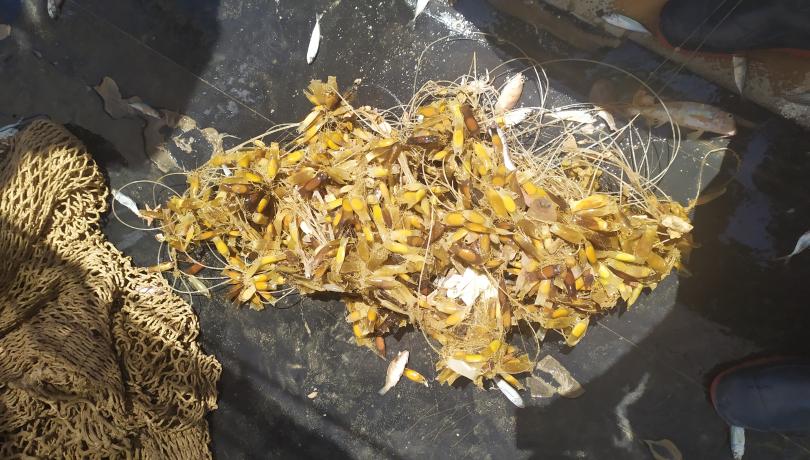Catsharks Resort to Plastic Substrates for Egg Laying in an Increasingly Degraded Mediterranean
This is the first study to document this change in behavior in catsharks / David Ruiz (UV).
This is the main conclusion of a new study published in the journal Science of the Total Environment, with contributions from experts Anna Sánchez-Vidal, from the Department of Earth and Ocean Dynamics at the Faculty of Earth Sciences, and Alberto Maceda, from the Department of Evolutionary Biology, Ecology, and Environmental Sciences at the Faculty of Biology and the Biodiversity Research Institute (IRBio) of the University of Barcelona.
According to the study, led by the ICM-CSIC, as plastic pollution increases and habitat-forming species decline, the species increasingly relies on plastic substrates to lay its eggs. Specifically, teams from the Institute of Marine Sciences (ICM-CSIC), in collaboration with the University of Valencia (UV), the University of Barcelona (UB), and the Catsharks Association, have discovered that the catshark (Scyliorhinus canicula), a small shark species native to the Mediterranean, is increasingly using plastic waste—particularly ghost fishing nets—as a substrate to lay its eggs. The details of this behavior, particularly evident in areas where natural biological substrates have become scarce, are now documented in the new study.
This is the first study to document this behavioral shift in catsharks, highlighting the alarming impact of plastic pollution and marine habitat degradation. "The implications of this change could be profound for the long-term survival of catsharks," says Blanca Figuerola, a researcher at the ICM-CSIC and a member of the Medrecover group.
As plastic pollution increases and habitat-forming species decline, catsharks depend more and more on artificial materials. While the impact of this change is not yet fully understood, researchers warn that it could affect the survival, fitness, and dispersal of the species. "At first glance, plastics may seem like a good place for embryos to develop, but these artificial substrates do not offer the same benefits as habitat-forming species, which provide shelter and food for both catsharks and their prey," notes Figuerola.
As indicated by Anna Sánchez-Vidal, researcher at the UB and member of the Consolidated Research Group in Marine Geosciences, "Our research suggests that environmental pressures, coupled with the increasing presence of plastics in the oceans, are driving some species to adapt in unexpected ways. This is a clear example of how human-induced changes are affecting marine life."
The study also reveals that catsharks prefer to lay their eggs on biological substrates such as hydrozoans and sponges in shallow waters. However, in deeper areas, they more frequently resort to tube-dwelling polychaetes and plastic waste as an alternative. "This trend is especially notable on the continental slope, where natural habitats are severely impacted by human activities such as fishing," explains Claudio Barría, co-author of the study and member of Catsharks.
Faced with this scenario, the scientific team warns of the long-term consequences this behavior could entail. Although the immediate effects on catshark populations are not yet fully understood, there is concern that eggs attached to plastic debris may be carried to areas with conditions unsuitable for embryo development. David Ruiz, principal co-author of the study and scientist at UV, warns that "if juveniles survive, this could lead to increased competition for resources and the displacement of other species."
This team had already anticipated that plastic debris could be used by catsharks for egg laying in a previous study. Since there were no prior studies analyzing this behavior or the factors influencing substrate preference for egg laying, the scientists decided to delve deeper into the issue.
Overall, the study highlights the urgent importance of preserving biological habitats and combating plastic pollution at its source, especially in vulnerable areas like the Mediterranean. "Without immediate action, we could see more species adopting similar behaviors, which would have potentially devastating consequences for marine ecosystems," warns the research team.
Reference article: Figuerola, B.; Ruiz-García, D.; Subías-Baratau, A.; Maceda-Veiga, A.; Sanchez-Vidal, A.; Barría, C. "Adapting to a pollution hotspot? Catsharks shift to plastic substrates for oviposition." Science of The Total Environment, October 2024. DOI: 10.1016/j.scitotenv.2024.176998
